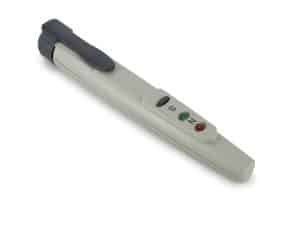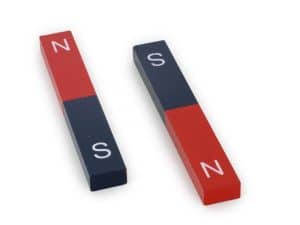Polarity Checkers and Pole Identifiers
Showing all 2 results
Buy Polarity Checkers and Pole Identifiers online with e-Magnets™
For many applications a magnet is used to simply pull onto a ferromagnetic plate. In such applications, is does not matter if a North face or a South face is facing the mild steel plate – either side will perform the task. In other applications it is important to know which face of the magnet has a North or South. Two examples would be magnet pulling onto magnet in a door closure application (where a North face of one magnet must attract a South face of the other magnet) and a Hall Effect switch/trigger application where the trigger only occurs if the magnetic field is in a certain direction. In such circumstances it is important to know where the North and South faces are to correctly assemble the magnets in the application. As such a means of performing a Magnet Polarity Test is required.
To identify a magnet polarity (and the therefore determine a magnet’s Direction of Magnetisation, DoM) there are two methods for performing a Magnet Polarity Test.
The first method for a Magnet Polarity Test is to use a magnet of known Direction of Magnetisation. Some magnets already have a dimple on one Pole face which typically identifies a North face but this is not guaranteed from manufacturer to manufacturer (our magnets, where a dimple exists, show that face to be a North Pole face). We offer Alnico bar magnets which have the North and South ends clearly marked with a “N” and “S” respectively (E500). To identify the North and South Poles of an unmarked magnet, you should use the method of like Poles repelling. Bring the North Pole of the E500 Alnico magnet to the unmarked magnet and rotate the unmarked magnet until you get repulsion between magnet faces. The face of the unmarked magnet that is repelling is therefore a North face. Turn the E500 Alnico magnet around so the South face is towards the magnet being tested and repeat the process to identify the South face of the tested magnet. This will correctly identify the North and South Poles of an unmarked magnet (testing multipole magnets may require a Gaussmeter). Testing by using attraction can give false results as the non-Pole sides can sometimes be attracted to another magnets giving an impression that are magnetised sides.
The second method for a Magnet Polarity Test is to use an electronic Magnetic Polarity checker (MPI-1). The end of the device is put against the magnet face and the test button is pressed. The red LED lights up if the magnet face is a North Pole (of more than +17mT / +170Gauss field strength). The green LED lights up if the magnet face is a South Pole (of less than -17mT / -170Gauss field strength). The internal circuitry is based on Hall Effect Devices.
An alternative method is to use a compass and the pointer of the compass will point to the North Pole. It should be noted that the compass can be accidentally magnetised in the opposite direction so may identify a Pole but of the wrong ‘sign’ (we recommend testing the compass against Geographic North or a known North face of a magnet before using it for Pole identification).


